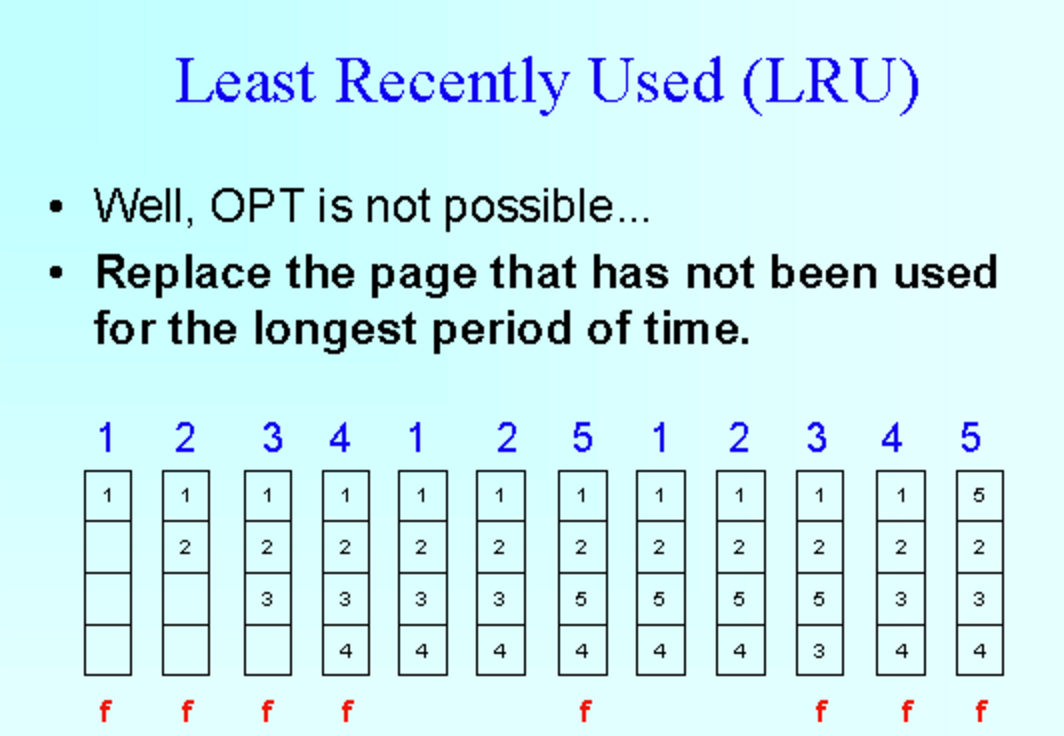LRU和LFU缓存置换算法
作者: 康凯森
日期: 2016-05-05
分类: 算法
为什么需要Cache
- 为了解决俩个存储介质之间的速度不匹配,比如CPU和内存,比如内存和磁盘,比如本地和服务端。
- 依据程序访问的局部性原理,近期访问的数据,在将来很有可能会被访问
Cache是什么
可以简单认为是一个HashMap,是一个key-value 结构,用来加速访问。
Cache无处不在
缓存的种类:本地服务器缓存、网页缓存、硬盘缓存、一级高速缓存、二级高速缓存等
常用的Cache服务器
- Memcache
- Redis
为什么需要 Cache
因为Cache在内存中,所以存储效率高
为什么不全放在 Cache中
- 内存的数据断电就会丢失
- Cache比硬盘贵
为什么Cache需要置换
Cache工作原理要求它尽量保存最新数据,但是Cache一般大小有限,当Cache容量达到上限时,就会产生Cache替换的问题。最理想的情况是置换出未来短期内不会被再次访问的数据,但是我们无法预知未来,所以只能从数据在过去的访问情况中寻找规律进行置换。
LFU Cache置换算法
Least Frequently Used algorithm
LFU是首先淘汰一定时期内被访问次数最少的页!
这种算法选择近期最少访问的页面作为被替换的页面。显然,这是一种合理的算法,因为到目前为止最少使用的页面,很可能也是将来最少访问的页面。

代码如下:
/**
* Created by kangkaisen on 16/5/4.
*/
import java.util.*;
public class LFUCache {
private static final int DEFAULT_MAX_SIZE = 3;
private int capacity = DEFAULT_MAX_SIZE;
//保存缓存的访问频率和时间
private final Map<Integer, HitRate> cache = new HashMap<Integer, HitRate>();
//保存缓存的KV
private final Map<Integer, Integer> KV = new HashMap<Integer, Integer>();
// @param capacity, an integer
public LFUCache(int capacity) {
this.capacity = capacity;
}
// @param key, an integer
// @param value, an integer
// @return nothing
public void set(int key, int value) {
Integer v = KV.get(key);
if (v == null) {
if (cache.size() == capacity) {
Integer k = getKickedKey();
KV.remove(k);
cache.remove(k);
}
cache.put(key, new HitRate(key, 1, System.nanoTime()));
} else { //若是key相同只增加频率,更新时间,并不进行置换
HitRate hitRate = cache.get(key);
hitRate.hitCount += 1;
hitRate.lastTime = System.nanoTime();
}
KV.put(key, value);
}
public int get(int key) {
Integer v = KV.get(key);
if (v != null) {
HitRate hitRate = cache.get(key);
hitRate.hitCount += 1;
hitRate.lastTime = System.nanoTime();
return v;
}
return -1;
}
// @return 要被置换的key
private Integer getKickedKey() {
HitRate min = Collections.min(cache.values());
return min.key;
}
class HitRate implements Comparable<HitRate> {
Integer key;
Integer hitCount; // 命中次数
Long lastTime; // 上次命中时间
public HitRate(Integer key, Integer hitCount, Long lastTime) {
this.key = key;
this.hitCount = hitCount;
this.lastTime = lastTime;
}
public int compareTo(HitRate o) {
int hr = hitCount.compareTo(o.hitCount);
return hr != 0 ? hr : lastTime.compareTo(o.lastTime);
}
}
public static void main(String[] as) throws Exception {
LFUCache cache = new LFUCache(3);
cache.set(2, 2);
cache.set(1, 1);
System.out.println(cache.get(2));
System.out.println(cache.get(1));
System.out.println(cache.get(2));
cache.set(3, 3);
cache.set(4, 4);
System.out.println(cache.get(3));
System.out.println(cache.get(2));
System.out.println(cache.get(1));
System.out.println(cache.get(4));
}
}
LRU Cache置换算法
Least Recently Used algorithm
LRU是首先淘汰最长时间未被使用的页面!
这种算法把近期最久没有被访问过的页面作为被替换的页面。它把LFU算法中要记录数量上的"多"与"少"简化成判断"有"与"无",因此,实现起来比较容易。

代码如下:
import java.util.HashMap;
/**
* Created by kangkaisen on 16/5/5.
*/
//实现起来比较简单. 维护一个链表,每次数据新添加或者有访问时移动到链表尾,
//每次淘汰数据则是淘汰链表头部的数据.
//也就是最近最少访问的数据在链表头部,最近刚访问的数据在链表尾部
public class LRUCache {
private class Node{
Node prev;
Node next;
int key;
int value;
public Node(int key, int value) {
this.key = key;
this.value = value;
this.prev = null;
this.next = null;
}
}
private int capacity;
private HashMap<Integer, Node> hs = new HashMap<Integer, Node>();
private Node head = new Node(-1, -1);
private Node tail = new Node(-1, -1);
// @param capacity, an integer
public LRUCache(int capacity) {
// write your code here
this.capacity = capacity;
tail.prev = head;
head.next = tail;
}
// @return an integer
public int get(int key) {
// write your code here
if( !hs.containsKey(key)) {
return -1;
}
// remove current
Node current = hs.get(key);
current.prev.next = current.next;
current.next.prev = current.prev;
// move current to tail
move_to_tail(current);
return hs.get(key).value;
}
// @param key, an integer
// @param value, an integer
// @return nothing
public void set(int key, int value) {
// write your code here
if( get(key) != -1) {
hs.get(key).value = value;
return;
}
if (hs.size() == capacity) {
hs.remove(head.next.key);
head.next = head.next.next;
head.next.prev = head;
}
Node insert = new Node(key, value);
hs.put(key, insert);
move_to_tail(insert);
}
private void move_to_tail(Node current) {
current.prev = tail.prev;
tail.prev = current;
current.prev.next = current;
current.next = tail;
}
public static void main(String[] as) throws Exception {
LRUCache cache = new LRUCache(3);
cache.set(2, 2);
cache.set(1, 1);
System.out.println(cache.get(2));
System.out.println(cache.get(1));
System.out.println(cache.get(2));
cache.set(3, 3);
cache.set(4, 4);
System.out.println(cache.get(3));
System.out.println(cache.get(2));
System.out.println(cache.get(1));
System.out.println(cache.get(4));
}
}
参考资料
缓存中的算法-RAND算法,FIFO算法,LFU算法,LRU算法,OPT算法
缓存淘汰算法 —— LFU-Aging(Java实现) 该算法不正确
TalkCody 欢迎 Star&共建
欢迎关注微信公众号
